Samsung to excite mobile photographers with newest in Galaxy J series
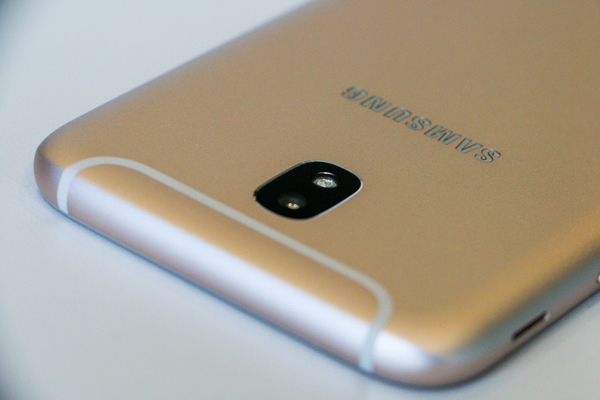
MANILA, Philippines — Aperture, ISO, shutter speed, exposure and focus. These are the five key elements in cameras that both professional and amateur photographers master to produce good images.
By combining the right ISO with correct shutter speed, they can capture landscapes in low-light conditions. By adjusting the aperture and exposure, they can neutralize harsh lighting. By choosing a focal point, they can highlight an important subject amidst a broad background.
Only photographers who prefer to shoot in manual mode using their bulky and heavy DSLRs are able to do all those. But not anymore.
Today, the possibilities in photography are becoming endless thanks to latest smartphones that now feature manual camera modes. This has given rise to so-called “mobile photography.”
Rulers of ‘middle’ market
In the mid-range smartphone market, several brands are creating a buzz among photography enthusiasts.
You might be familiar with Samsung as a company that has been in the business of pushing the envelope in mobile photography, especially in low-light photography, starting off with its flagship release last year with the Galaxy S7’s F/1.7 aperture camera lens.

Both Samsung and Oppo have 13-megapixel rear cameras but which of the two produced better images? Philstar.com/EC Toledo
A lot of different smartphone brands followed suit in bringing in more to the table to get those great photos. One of them is Oppo, a global smartphone maker with Chinese roots. In May, it has released the Oppo F3 with outstanding cameras. On its rear, its 13-megapixel and F/2.2-aperture lens shoots in Expert Mode with autobalance, shutter speed, ISO, focus and raw settings. Up front, its dual lens enables a wide angle perfect for groufies.
But while this sounds very promising, Korea’s smartphone giant is set to release a contender that will stir up the competition in the Philippines this month. Now, Samsung goes beyond just the flagship line, and is now extending this expertise on mobile photography (especially with its mid-range line up).
This is the Galaxy J7 Pro, with its 13-megapixel rear camera carries much larger aperture at F/1.7, which is already equivalent to most DSLR lenses. This is great, because a larger aperture means having the capability to capture more light for your photos.
It also shoots in different modes, namely Auto, Night, Panorama, Continuous, HDR, Sports, Sound & Shot, and of course, Pro—or manual.
While the rear camera is the main strength for Samsung’s newest mid-range smartphone, its selfie camera is still a force to reckon. Its 13-megapixel, F/1.9-aperture lens is almost equivalent to that of the rear in terms of capturing more light. Moreover, it also comes with an LED flash, on top of built in filters.
Effortless shooting at night
Philstar.com has put both the Oppo F3’s and the Galaxy J7 Pro’s rear cameras to test and what better way to do it than shooting at night. The Bonifacio Global City in Taguig has served as our picturesque setting with its rising skyscrapers and posh lifestyle hubs.
First up was the Oppo F3, in which we first relied on Expert Mode. Our preferred setting was 800 ISO (max), 1/5-second shutter speed. We also adjusted brightness depending on the lighting with the exposure button. The results are images with sharp contrast between highlights and shadows.
Then we tested Galaxy J7 Pro’s Night Mode, easily accessible by swiping the screen to the right after launching the camera. Lo and behold, the quality we produced using the Galaxy J7 Pro’s auto night setting is at par with the Oppo F3’s manual setting. This we attribute to the former’s superior F/1.7, which in photography essence, absorbs all available light in the surrounding—be it daytime or nighttime.
The Night Mode thus allows users to shoot pictures effortlessly at night without having to think about the right ISO, exposure, and shutter speed settings. For this, we give Samsung’s Galaxy J7 Pro a two thumbs up.
Still at Bonifacio Global City, we also shot in Auto Mode for both smartphones. Without fixing the Oppo F3’s camera settings, its photos came out darker and unfortunately, paler and grainier. Whereas the Galaxy J7 Pro’s images in Auto Mode remained crisper and brighter with warmer tones.
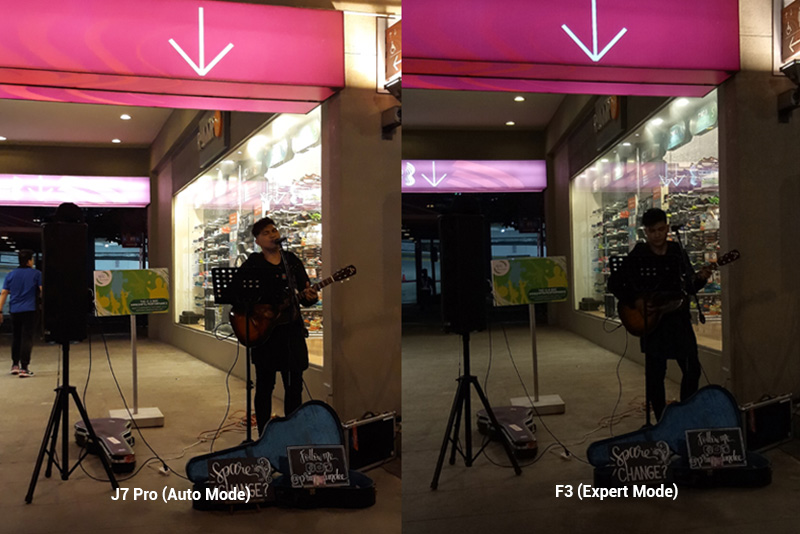
We also shot in Auto Mode for both smartphones and the difference was evident. Photos by Galaxy J7 Pro (left) remained crisper and brighter while those by Oppo F3 (right) became darker and grainier. Philstar.com/Euden Valdez
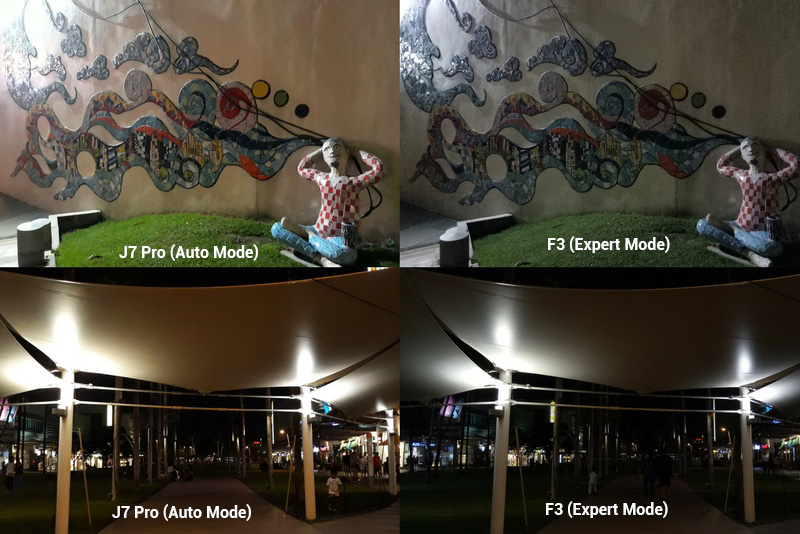
We also shot in Auto Mode for both smartphones and the difference was evident. Photos by Galaxy J7 Pro (left) remained crisper and brighter while those by Oppo F3 (right) became darker and grainier. Philstar.com/Euden Valdez
Other lighting conditions
We then gave both smartphones second tries in two low-lighted settings: an indoor art gallery and a dim office.
In both instances, we experienced the prior issues we had with the Oppo F3’s rear camera even if we adjusted its ISO settings from 100 to 400 to 800. This is true in the office photos we produced. Yes, there were changes in brightness but overall quality was dull.
The Galaxy J7 Pro, on the otherhand, delivered clearer images as proven by the vivid colors of the paintings in the gallery. We also adjusted its ISO from 100 to 400 and 800 in the office. The transformation of the photos convinced not only in brightness but also in color and clarity.
However, we must admit that the Oppo F3 had wider lens for better and bigger angles. We particularly loved this during daytime when light is abundant.
Still, we could not help but notice how the Galaxy J7 Pro’s images were higher in resolution resulting to better picture quality—an indicator on how Samsung continues to dominate the mobile arena for years.
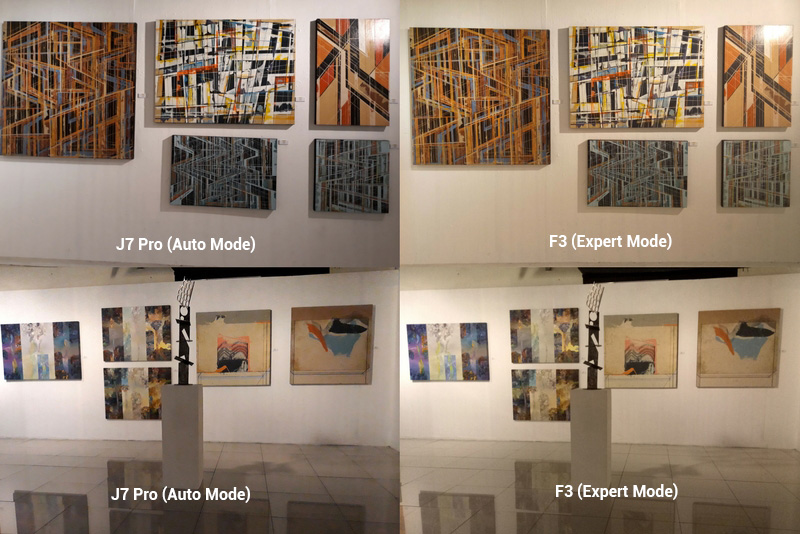
Galaxy J7 Pro delivered clearer images as proven by the vivid colors of the paintings in the gallery, while Oppo F3 produced softer and warmer shots. Philstar.com/Euden Valdez
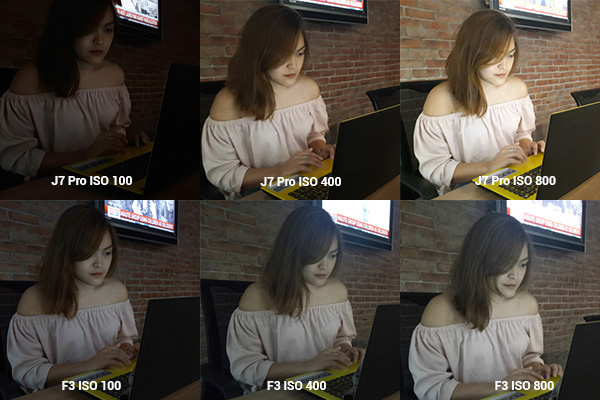
Photos by Galaxy J7 Pro proved that despite increase in ISO in low-lighted conditions, color and clarity were maintained. Unfortunately, Oppo F3 performed poorly on this test. Philstar.com/EC Toledo
Which is better?
After dissecting both the smartphones’ cameras, let’s now establish how the Samsung Galaxy J7 Pro is further poised to challenge Oppo F3.
As the latest in Samsung’s mid-range Galaxy J series, the Galaxy J7 Pro has some pretty neat upgrades. It now runs on the latest Android 7.0 (Nougat) operating system and on Octacore 1.6GHz processor.
And although released only months from each other, the Galaxy J7 Pro is more advanced already. The Oppo F3’s internal specifications include the Android 6.0 (Marshmallow) and an Octacore 1.5GHz processor.
Because it’s a powerful smartphone, the Galaxy J7 Pro offers vibrant viewing experience with the Full HD Super AMOLED screen (resolution up to 1920 x 1080 pixels). We watched movies from VOD providers, as well as played mobile games and we loved what we saw in its 5.5-inch display. Also, it’s LTE-powered, so browsing and playing will never be interrupted from lags—as long as you have good internet provider.
Aesthetics-wise, the Galaxy J7 Pro comes in a full metal unibody that is smooth to touch. When the screen is off, the Always on Display feature (which used to be an exclusive feature limited to flagship smartphones) shows the time and notifications around the clock.
To further entice mobile photographers, the Galaxy J7 Pro gives them a 3GB ram and 32GB memory, which can be expanded to 256GB with a micro SD card.
More importantly, the Galaxy J7 Pro’s 3,600 mAh battery—slightly higher compared to Oppo F3’s 3200 mAh battery—will last even after a full day of usage.
We also suggest to maximize Samsung’s tried and tested security features like the latest Finger Scanner.
So which is better between the Galaxy J7 Pro and Oppo F3?
It still boils down to the user’s perspective. Will you stick to Samsung, which has already gained the trust of millions of people around the globe, or will you try why Oppo is fast gaining a solid foothold in the industry?




















